2020-2029 Contents
2020-2035 - World energy crisis
2020 - Internet use reaches 5 billion worldwide | Texting by thinking | Complete organ replacements grown from stem cells | Holographic TV is mainstream | Sweden becomes the first oil-free country |
Glacier National Park and other regions are becoming ice-free | Completion of the Square Kilometre Array | Wholly lifelike CGI
2021 - "Thoughtcrime" is becoming a reality | Fully reusable single-stage-to-orbit spacecraft | Telecommuting is a standard flexible work option | Traditional microchips are reaching the limits of miniaturisation | Water crisis in southwest USA
2022 - Nanotech clothing enters the mass market | Tooth regeneration is transforming dental care | Piezoelectric nanowires are appearing in high-end products | Deafness is curable
2023 - Laser-driven fusion energy makes progress | Borneo’s rainforests have been wiped from the map | Gorillas are extinct in Central Africa | Turkey becomes self-sufficient in energy production
2024 - The biggest refugee crisis in world history | African elephants are on the brink of extinction
2025 - Human brain simulations are possible | Medical nanobots are becoming available | China's economy continues to boom | Vertical farms are appearing in many cities | High-speed rail networks are being expanded in many countries | Africa and the Middle East are linked by a transcontinental bridge | Progress with longevity extension | Stress and anxiety is reaching crisis levels | Contact with the Voyager probes is lost
2026 - Rising sea levels are wreaking havoc on the Maldives | The United States of Africa is established
2027 - BRICs overtake the G7 nations | Carbon sequestration is underway in many nations
2028 - Printed electronics are ubiquitous | UK population reaches 70m | Manned fighter planes are being phased out and replaced with UAVs | Amputees can regrow lost limbs
2029 - Human-like AI is becoming a reality | Automation of supermarkets and retail environments | Intelligent advertising | Titan Saturn System Mission (TSSM) | Lake Chad disappears from the map
2000-2009 | 2010-2019 | 2020-2029 | 2030-2039 | 2040-2049 | 2050-2059 | 2060-2069 | 2070-2079 | 2080-2089 | 2090-2099 >
World energy crisis*
Throughout this period the world is thrown into turmoil as demand for oil begins to greatly exceed supply - crippling many economies and triggering widespread social unrest.*
There are major conflicts throughout the Middle East and Central Asia. The most significant of these resource wars actually involves the one-off use of a tactical nuclear weapon.
The crisis plays out for nearly two decades, gradually being resolved by a switch to renewable energy and alternative fuel technologies - but the transition is by no means a smooth one. By the mid-2030's, the geopolitical map of the Middle East is almost unrecognisable compared with 20 years previously.
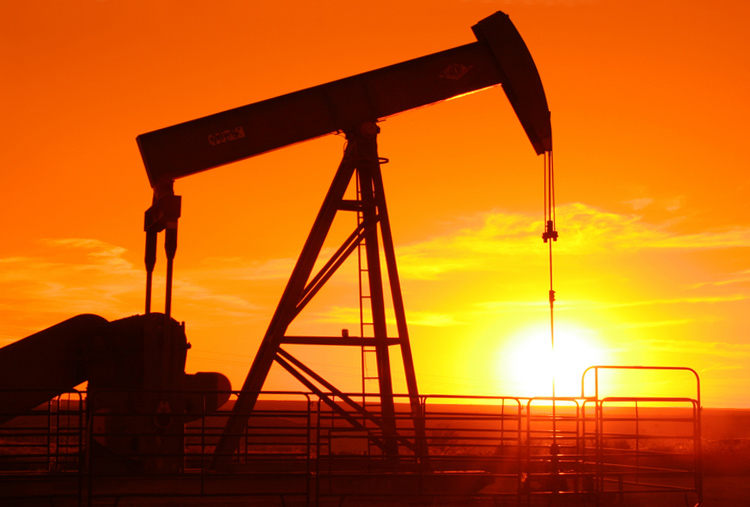
© Douglas Knight | Dreamstime.com
Internet use reaches 5 billion worldwide
The number of Internet users has now reached almost 5 billion - equal to the entire world's population circa 1987. This compares with 1.7 billion users in 2010 and only 360 million in 2000.*
Vast numbers of people in developing countries now have access to the web, thanks to a combination of plummeting costs and exponential improvements in technology. This includes laptops that can be bought for only a few tens of dollars, together with explosive growth in the use of mobile broadband. Even the most remote populations on Earth can take advantage of the Internet, thanks to the infrastructure now in place.*
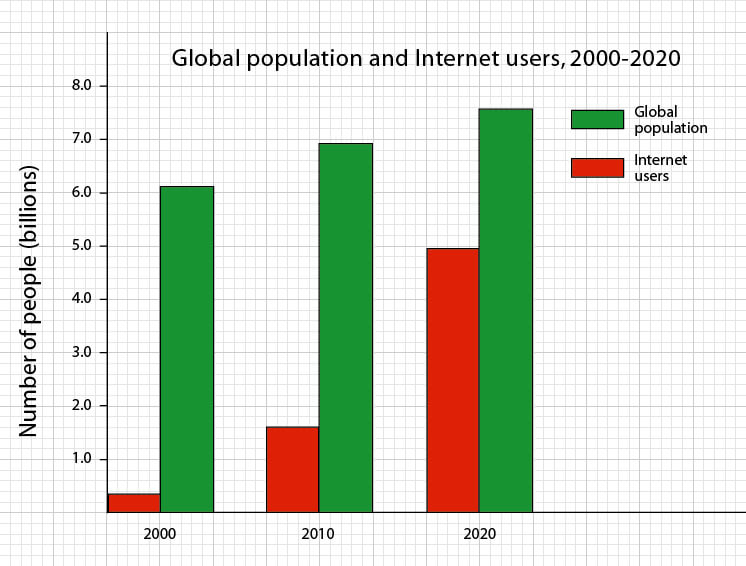
Texting by thinking
In 2020, mobile phones are becoming available with the option of texting by thought power alone.*
A sensor-mounted headset is worn by the user. This contains brain-machine interface technology, which analyses brain waves and converts them into digital signals.*
Some of the higher end models feature glasses or visors, with displays built into the lenses. This allows completely hands-free texting, effectively creating a form of electronic telepathy. The process is rather slow at this stage - requiring a high degree of concentration - but advances in the coming decades will revolutionise communication.
Complete organ replacements grown from stem cells
In the previous decade, it was already possible to grow individual tissues, tendons and cartilages from stem cells. By 2020, scientists have fully characterised how every part of the heart works - enabling them to grow complete replacements for use in transplants.*
The need for external donors is eliminated, and since the organ is genetically matched to the patient, there is no chance of rejection. Natural, living tissue is also far more flexible, sophisticated and efficient than artificially built components - so this new treatment offers radical hope to millions of people affected by cardiovascular disease. Until now, around 15m people have died each year from heart-related conditions.
The economic benefits are huge. A significant fraction of healthcare costs have been attributable to organ failure, the recurring treatments for chronic diseases and their subsequent complications. This new regenerative medicine effectively provides a cure, rather than ongoing treatment. Until now, direct healthcare costs of organ replacement and associated care have been $350 billion globally (about 8 percent of global healthcare spending).
As well as the heart, various other organs are developed over the subsequent decade: lungs, livers, kidneys, spleens, stomachs and sexual organs all become available by 2030. Internal organ failure is gradually becoming a thing of the past; for those who can afford the treatments, at least.
Combined with new vitrification techniques* (which allow organ banking without damage from ice crystal formation), this is a major breakthrough in longevity extension.
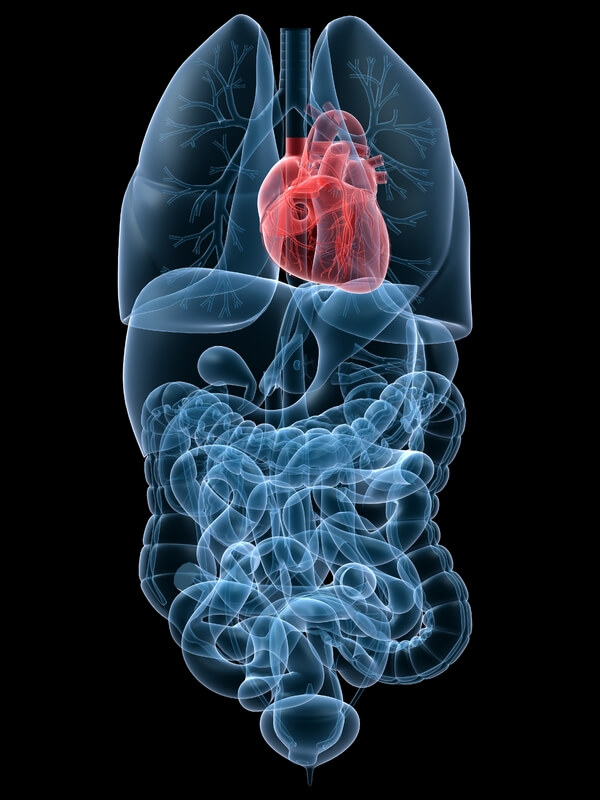
© Sebastian Kaulitzki | Dreamstime.com
Holographic TV is mainstream
Breakthroughs in rewritable and erasable systems have made it possible to mass-market the first truly holographic TV displays.*
This form of technology had been in development for nearly three decades. One of the main problems encountered was that the displays required a lengthy delay between each "rewrite" - making it impractical for televisual displays. However, recent advances in power transfer have overcome this problem, with displays now capable of running at 24 frames per second.
Typical holographic screens of this period are relatively small. They are also very expensive, and still viewed as a luxury item for now. However, further refinement of this technology leads to bigger, more powerful displays; while competition between the major vendors later succeeds in bringing down costs, making them affordable to the majority of people.
The screens can either be fixed to a wall (with all the image writing lasers behind the wall), or placed horizontally on a table (with all the components underneath).
Initially popular in Japan and the Far East, the displays rapidly find their way to the rest of the world and make traditional CRT and LCD screens obsolete.
Over the next few decades perfection of this technology will see entire rooms turned into holographic environments.
Sweden becomes the first oil-free country
This has been achieved through large-scale investments in renewable energy, massive tax incentives and grants for scientific research, and a detailed programme of energy conservation. The country is powered entirely by zero-carbon technologies, and has rid itself completely of gasoline cars and oil-heated homes.* From this decade onwards, Sweden experiences massive prosperity and growth.
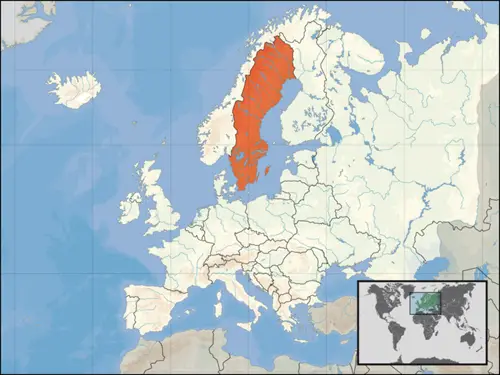
Credit: David Liuzzo
Glacier National Park and other regions are becoming ice-free
By now, the Glacier National Park in Montana has become completely ice-free, the park's namesakes having disappeared as a result of global warming.
 |  |  | 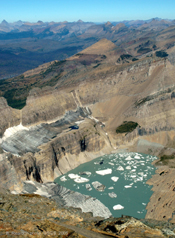 |
1938 | 1981 | 1998 | 2005 |
An earlier model (shown below) had forecast this event for 2030, based on a study by the US Geological Survey, along with 1992 temperature predictions by the UN's Intergovernmental Panel on Climate Change (IPCC). However, updated computer models and fresh data obtained in 2009 indicated a temperature rise more than twice as rapid as previously thought.*
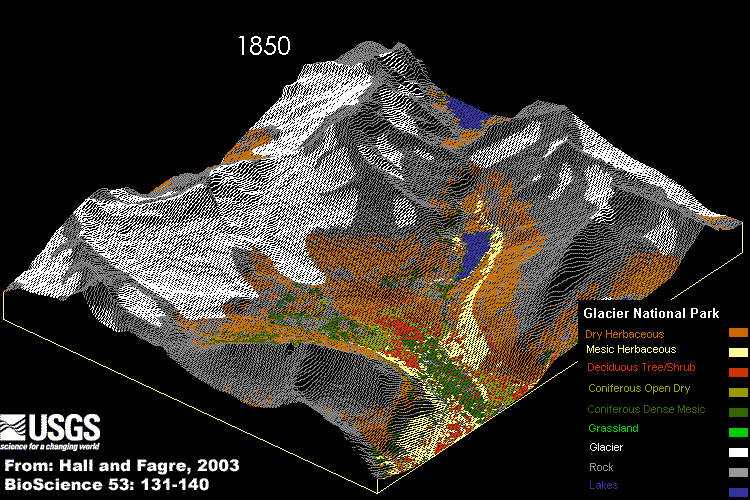
As early as 2020, therefore, the glaciers were gone, leaving behind only barren rock. Many cold water dependent plants and animals subsequently died out due to loss of habitat - including a number of rare species. Reduced seasonal melting of ice also affected stream flow during the dry summer and fall seasons, reducing water table levels and increasing the number of forest fires. This had the added effect of putting more carbon into the atmosphere. The loss of glaciers also reduced the aesthetic visual appeal of the region for visiting tourists.
This process is being mirrored all over the world, with non-polar ice beginning to vanish from many prominent regions including the Andes, Alps, Himalayas and Kilimanjaro.
Later this century, glacier loss from the Himalayas will have a devastating impact - destabilising much of the Indian subcontinent, including the nuclear-armed Pakistan. Floods and mudslides will be the initial result of the melting; but afterwards, fewer and smaller glaciers will mean less run-off to rivers such as the Ganges that would normally provide fresh water for drinking, agricultural production and hydroelectric power generation. Given that the Mekong, Yangtze and Yellow rivers are affected too, this means water shortages for potentially 2.5 billion people.*
Completion of the Square Kilometre Array
Our view of the universe is greatly expanded with the completion of a major new observatory in Australia.* This is a radio telescope with a total collecting area of approximately one kilometre. It operates over a wide range of frequencies and its size makes it 50 times more sensitive than any other radio instrument. By utilising advanced processing technology, it can survey the sky more than 10,000 times faster than ever before. With receiving stations extending to a distance of 3,000 km from a concentrated central core, it continues radio astronomy’s tradition of providing the highest resolution images in all of astronomy.
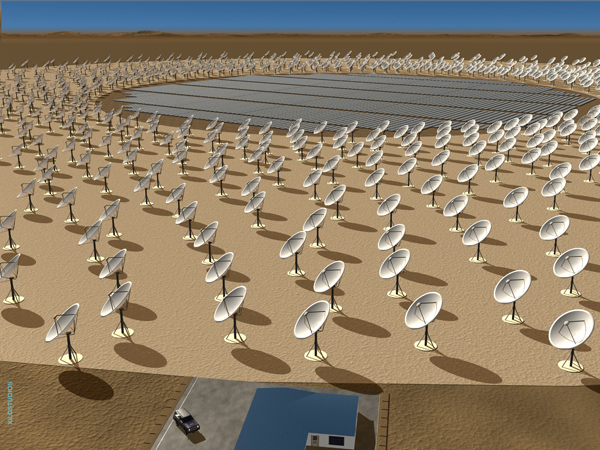
Credit: Xilostudios and ISPO
Wholly lifelike CGI
Computer-generated people used in the latest video games now achieve a wholly lifelike appearance. Advances in modelling techniques have allowed programmers to recreate the subtlest of movements, facial expressions, lighting and other physical effects. Complex animated scenes featuring entirely computer-rendered people are becoming indistinguishable from reality.*
"Thoughtcrime" is becoming a reality
Twenty years on from 9/11, mind readers are now a common feature of airport security, as well as sports stadiums and other high profile events. This technology faced problems to begin with, as there were false positives recorded by the machines – but recent advances in neuroscience and computer analysing software have greatly improved their accuracy.*
The system uses "non-invasive" sensors and imagers. These observe a person's emotional state, facial expression, body language, body temperature, heart rate, breathing pattern and other cues. Analysed together, these factors can determine whether they are planning to commit a crime.
Specific words, phrases and imagery within the person's brain are still years away from being fully decipherable. However, it is now possible to establish their basic, overall intentions beyond any reasonable doubt.*
This technology is also replacing the lie detectors used in courtroom settings.

© Andrius Grigaliunas | Dreamstime.com
Fully reusable, single-stage-to-orbit spacecraft
Until now, all orbital spacecraft have used multiple stages. This has required jettisoning parts of a launch vehicle during the flight, in order to reduce weight. In the early 2020s, however, a new prototype "space plane" is developed with funding from the EU. This can operate without the need for booster rockets, fuel tanks, engines or other external components, instead utilising a hybrid jet/rocket system.*
The vehicle takes off from a specially strengthened runway. It uses a precooled jet engine (rather than scramjet) to reach speeds of Mach 5.5 (1700 m/s), then closes the air inlet and operates as a highly efficient rocket to complete the journey to orbit.
Although its payload is only 12 tons (about one-third the capacity of the space shuttle), the craft is substantially cheaper (about 1/10th) and far more efficient (about 400-fold) than earlier spacecraft.* After completing a mission, it reenters the atmosphere with its skin protected by a strong ceramic, landing back on the runway like a normal aeroplane. It then undergoes any necessary maintenance and is capable of flying again in just two days (compared to two months for the space shuttle).
These planes are initially unmanned. However, later versions will be used for space tourism – capable of transporting up to 20 passengers in a purpose-built module and costing around $500,000 per person.*
Telecommuting is a standard flexible work option
In an effort to cut real estate costs, become more eco-friendly and attract the growing number of people seeking work-life balance, most companies by now have adopted a "work wherever you want, whenever you want" policy.
An increasingly global talent pool is emerging, with companies aggressively pursuing the best available workers, regardless of where they reside. Combined with superfast broadband in the home, telecommuting has grown tremendously as a result.
In addition, soaring fuel costs have led to many office-based employees working a four-day week, usually consisting of four 10-hour days.
In today's corporate workplaces, multi-touch surface computing is becoming ubiquitous - along with seamless integration of wireless devices and applications. Near-paperless offices are becoming a reality.
This combination of advanced technologies and flexible work options is leading to greatly improved speed, productivity and efficiency in companies around the world.
Traditional microchips are reaching the limits of miniaturisation
Semiconductor companies are reaching the limits of miniaturisation for computer chips. The smallest transistors are now being built with 11-nanometre manufacturing processes. This is close to the size of individual atoms. Silicon is impossible to scale below this size, due to the effects of quantum tunnelling.
Moore's Law - the trend which has seen computer power doubling every two years - enters a new paradigm shift, with traditional microchips abandoned in favour of "stacked" 3-dimensional circuits made from carbon nanotubes.*

© Norman Chan | Dreamstime.com
Water crisis in southwest USA
Southwestern parts of the USA – including Nevada, Arizona and southern California – are faced with crippling water shortages, on a scale normally only seen in Third World countries.
Lake Mead, a key source of water for more than 25 million people (or about 8% of the US population), has run dry as a result of climate change.* Increased population growth and associated demand for water resources have also played a part.
Once the largest reservoir in the country, it has declined to almost nothing due to the Colorado River’s net deficit of nearly 1 million acre-feet of water per year. This crisis has occurred despite mitigation measures implemented early in the previous decade.
As well as providing fresh water, Lake Mead has been a major source of hydroelectric power, via the Hoover Dam. Blackouts are now occurring across much of the area. Las Vegas and its famous lights are particularly hard hit. Authorities have been attempting to stabilise the situation by constructing solar power facilities both in and around the city, as well as laying groundwater pipelines from elsewhere in Nevada.* Improved methods of water conservation and new agricultural techniques are also being introduced. However, even these measures are proving to be insufficient, and major societal and economic disruption is unavoidable in the short term. A virtual exodus of people from the affected regions is underway during this time.
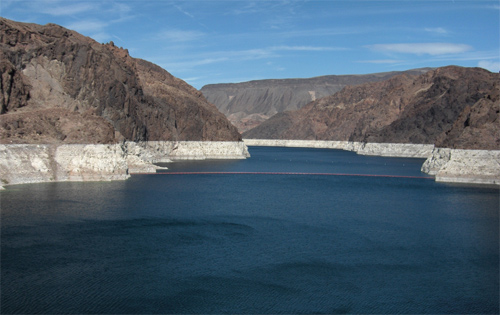
Above: Lake Mead as seen from the Hoover Dam, clearly showing the "bathtub ring".
Nanotech clothing enters the mass market
A variety of nanotechnology-based clothing is becoming mainstream now. This includes truly waterproof garments. These are made from polyester fibres coated with millions of tiny silicone filaments, structured in such a way that water simply falls off.*
Other textiles utilising nanotechnology include self-cleaning carpets. Millions of tiny fingers, embedded in the fabric, can be made to gently sway and lean towards the edge of the room, shifting dust and other garbage in a matter of minutes. Collectors fixed into the skirting board can then gather and dispose of any detritus as necessary. This has already been used in hotels, luxury apartments and high-grade office buildings - but is now entering the consumer market thanks to falling costs.
Nanotech is also being used extensively by the military, as well as police forces. Ultra-lightweight but extraordinarily impact-resistant jackets and body armour are becoming available. Fireproof suits can also be made safer using these new materials.

Credit: University of Zurich/Wiley Vch
Tooth regeneration is transforming dental care
Having been demonstrated in mice, bioengineered tooth regeneration is becoming available to humans. Using a combination of stem cells, scaffold material and signaling molecules, a fully functional and living tooth can be regrown in around two months - complete with roots, inner pulp and outer enamel.
Until now, dental implant therapies have required pre-existing high quality bone structures for supporting the artificial implants. Full reconstruction of natural, healthy teeth in patients without adequate bone support is therefore now possible. Fillings and dentures are becoming obsolete as a result, improving the health and well-being of many millions of people.*
Piezoelectric nanowires are appearing in high-end products
The piezoelectric effect, in which crystalline materials under mechanical stress produce an electric current, is now being utilised at the nanoscale level to power a variety of devices.*
Tiny vibrations - such as those created by wind, sound waves, friction, and even the turbulence of blood flow - can be captured and harnassed by a nanowire mesh. The bending of this mesh in response to these subtle forces can generate over 200 millivolts.
This form of self-powering technology is so sensitive, it can even be embedded in clothing. For instance, the subtle movements of a belt, shirt or trouser pocket can produce enough power to charge the batteries of a cell phone.
Implantable medical devices benefit particularly well from this. Hearing aids, for example, no longer require batteries since they can be powered by sound waves hitting them. Meanwhile, bone-loss monitors and other sensors can be activated by stresses to the body - then beam an alert signal to a computer.
Piezoelectric nanowires have a range of other applications. They can be used in engineering, for example, to detect microscopic fractures in an aeroplane or spacecraft. They can also be used in identity verification: a grid of piezoelectric wires underneath a signature pad (or other touchscreen device) can be used to record the pattern of pressure applied, which is then checked against a database.
Deafness is curable
Recent advances in stem cell research have provided a method of regenerating sensory cells within the inner ear. Humans are born with 30,000 cochlear and vestibular hair cells per ear. Unlike many animal species, they are unable to regenerate these when they are damaged. However, experiments with mice showed that it was possible to induce stem cells - as well as reprogrammed fibroblasts - into creating enough replacement hair cells to fully restore hearing. This process was then replicated in people.*
Using the patient's own skin as a source of stem cells means that the replacements are a perfect genetic match for their body, avoiding issues of immune rejection. This form of therapy also enables a variety of other ailments to be treated, such as balance disorders and tinnitus.
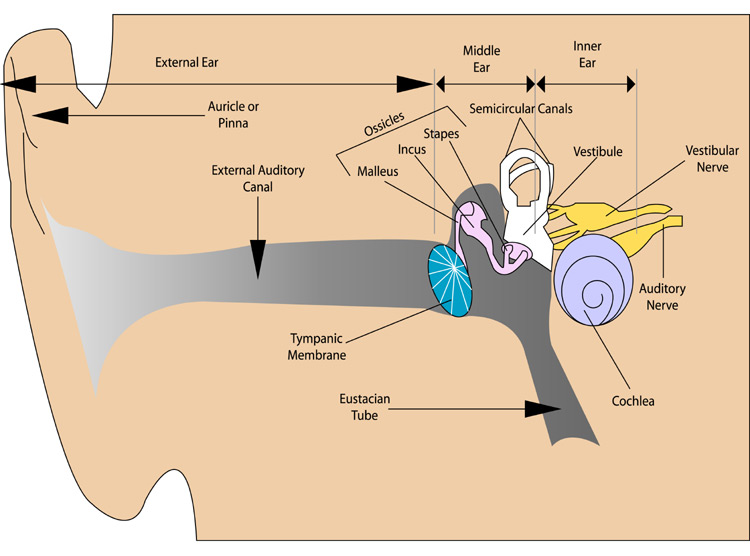
Credit: Madhero88 / Michal Komorniczak
Laser-driven fusion energy makes progress
Magnetic confinement - as seen in the ITER - has thus far been the preferred approach to studying fusion energy. However, the potential of lasers is now being explored in greater depth. Following years of engineering and construction, a major new research facility is operational in Europe.* This aims to demonstrate the feasibility of commercial-level fusion.
The High Power laser Energy Research facility (HiPER) uses a laser-driven inertial confinement reactor. Lasers are fired into a central core, where they collide with a single fuel pellet, compressing it to high density. A second laser is then fired, in a more intense pulse with nanosecond precision. This ignites the fuel, raising the core temperature to over a hundred million degrees celsius - hotter than the centre of the Sun - allowing fusion reactions to occur. Helium is formed, releasing energetic neutrons in the process. These neutrons are captured, generating electricity.
HiPER's "fast ignition" approach uses much smaller lasers than previous designs, yet generates power of the same magnitude. This offers a total "fusion gain" that is much higher than earlier devices, with a ten-fold reduction in construction costs.
HiPER is only a prototype - but when fully developed, fusion will become a revolutionary form of energy production. It will be a giant leap forward in addressing climate change, pollution, energy security and the ever increasing demand for consumption.
Borneo’s rainforests have been wiped from the map
The world’s 3rd largest island, Borneo was once home to a staggering range of biodiversity, covering hundreds of thousands of square kilometres. Its lush rainforests have now almost completely disappeared as a result of deforestation.* Many rare species are declared extinct around this time including the Orangutan – one of the most intelligent of the great apes.*
Gorillas are extinct in Central Africa
Rampant and uncontrolled poaching, together with large-scale deforestation, agriculture, mining, pollution, disease and militia operations have led to the terminal decline of gorilla populations.* Only those in captivity now remain.

Turkey becomes self-sufficient in energy production
While many countries are struggling with the effects of peak oil, a lucky few have benefited from recent new discoveries. Turkey, for example, has become entirely self-sufficient in energy production - with 10 billion barrels of oil reserves and over 1.5 trillion cubic meters of natural gas uncovered in the Black Sea.*
These huge reserves have enabled the country to completely end its dependence on foreign imports and meet its energy needs for at least the next 30 years. Turkey's standing in the world is increased significantly as a result, boosted further by its recent entry into the EU. Celebrations are also taking place this year to mark the 100th anniversary of the foundation of the republic.
New oil discoveries have also been made in Iran, Turkmenistan, Kazakhstan and China. More controversially, the frozen polar wastes of the Arctic and Antarctic are now being plundered for their fossil fuel reserves.

Credit: TheEmirr
The biggest refugee crisis in world history
Torrential flooding in southeast Asia - brought on by a combination of rising sea levels, melting glaciers and extreme weather events - is creating the biggest refugee crisis in world history. Bangladesh and other parts of the region are seeing literally tens of millions of men, women and children displaced from their homes.*
This unfolding horror is the first major crisis of the 21st century which can be attributed directly to global warming.
Although a number of different countries are affected, the disaster is centred on Bangladesh with its high population (over 150 million) and high density, situated in the low-lying Ganges River delta. With most of the country just a few metres above sea level - and with a flat topography - storm surges are flooding vast areas of land with virtually no hope of recovery. As well as the physical damage to infrastructure, salt in the ground means that fields up to 40km from the new coastline are rendered useless for growing crops.*
Millions are drowned, while many others die in the subsequent looting and chaos that sweeps the nation, and a whole series of conflicts begins to erupt along the border with India.* The sheer scale of this catastrophe makes it difficult to coordinate relief efforts. Relatively speaking, only token assistance can be offered by the UN.
Ironically, Bangladesh has contributed very little in the way of pollution blamed for accelerating climate change.
Credit: Raiyan Kamal
African elephants are on the brink of extinction
Despite efforts to curtail the ivory trade, huge numbers of elephants continued to be poached throughout Africa. Their population - which stood at 600,000 in 2009 - declined by nearly 40,000 each year.*
Only a handful remain in Africa today. Zoos and safari parks around the globe are now working to maintain a viable population for future rewilding.
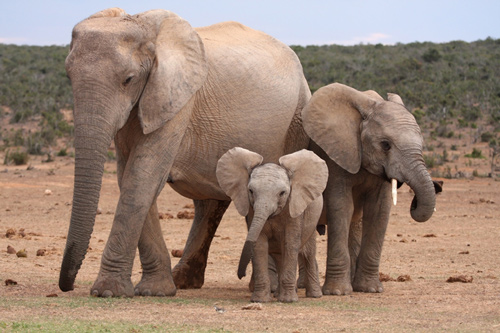
© Duncan Noakes | Dreamstime.com
Human brain simulations are possible
By now, the exponential growth in computing power - combined with the use of nanobots - has made it possible to form accurate models of every part of the human brain.
Between 2005 and 2025, there is a millionfold increase in computational power, along with vastly improved scanning resolution and bandwidth. Until recently, only separate regions of the brain had been modelled - but scientists are now able to combine them into one giant, complete simulation.
Much like the Human Genome Project of the 1990s, there were many in the scientific community who doubted the brain could be indexed and catalogued so quickly. However - like their predecessors - they failed to account for the Law of Accelerating Returns and its rapid snowball effect on the gathering of knowledge.*
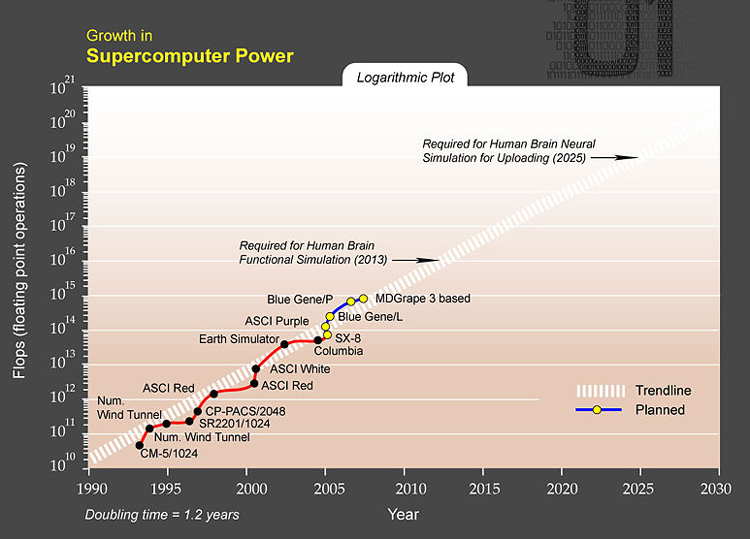
Creative Commons Attribution 1.0 / Credit: Ray Kurzweil
Medical nanobots are becoming available
Microscopic robots - measuring just a few nanometres across - are available for a variety of uses now. They are most commonly seen in medical applications, where their size enables them to reach places in the human body that were simply inaccessible before or too delicate for conventional instruments to operate on.
A number of the most important breakthroughs have been in the treatment of cancer, which can be detected earlier than ever before and targeted with far more precision. By the 2030s, more than 90% of cancers can be cured as a result of this. Even patients who would previously have been diagnosed as "terminally ill" can now be routinely saved. Monitoring of heart conditions, neurological disorders and countless other illnesses is also vastly improved. This, combined with enormous strides in stem cell research, is creating a new generation of medical treatments that is reaching a whole new level of sophistication and efficiency.
The nanobots themselves are built on a molecule-by-molecule basis, via positionally-controlled diamond mechanosynthesis and diamondoid nanofactories. Each robot is capable of propelling itself using tiny "motors" and is equipped with microscopic sensing, guidance and communication devices.
China's economy continues to boom
Much of China is now highly urbanised and densified. Its booming economy has led to the construction of literally tens of thousands of new skyscrapers all over the country. There are now over 200 cities with more than a million inhabitants, compared with just 35 in the whole of Europe circa 2010.* Even many remote and isolated places are beginning to see development on an unprecedented scale. Large-scale infrastructure such as maglev trains, airports, bridges and tunnels is forming an extensive network to all corners of the nation, leaving few areas untouched. China is well on its way to becoming a developed country.
Some of the largest metropolitan areas - such as Hong Kong and Shenzhen - actually begin to overlap and form "hyper cities", rivalling Tokyo in terms of population and land area. Many of the world's tallest buildings can now be found in China, including a number of kilometre-high "supertalls".
All of this has a considerable impact on the price of steel and other materials, which leads to cutbacks of many large-scale development projects in Europe, America and elsewhere. The rise of neighbouring India is adding to this. The West is now having a greatly reduced influence on setting the price of metals. Meanwhile, vast profits are being made by construction and mining firms, which leads to many high profile takeovers and acquisitions. At the same time, record numbers of accidents during this time - as a result of so much construction activity - lead to tighter regulations and improved safety in the industry. Better pay and working conditions for employees are subsequently introduced.
As China booms, its power requirements are soaring. The country has been preparing for this, however, by strengthening relations with Central Asian countries and importing more oil and gas from them, especially Turkmenistan which has made significant new discoveries. China’s entry into Central Asia was also partly motivated by the need to reduce its dependency on (a) the Middle East, and (b) the Malacca Strait for shipping oil from the Persian Gulf and Africa; a stretch of water that was becoming increasingly vulnerable to pirate attacks, and was the subject of ongoing political tensions regarding its control.
As well as strengthening its oil imports, substantial gains have been made from energy efficiency and conservation programmes, along with greatly increased use of nuclear power. By 2025 its nuclear power generating capacity is nearly 150 billion kilowatthours (khwh), passing that of Canada and Russia.* In the coming years, this will increase still further, as 4th generation nuclear power plants become available. Demands for environmental protection also lead to increased solar, wind and hydro-electric power.
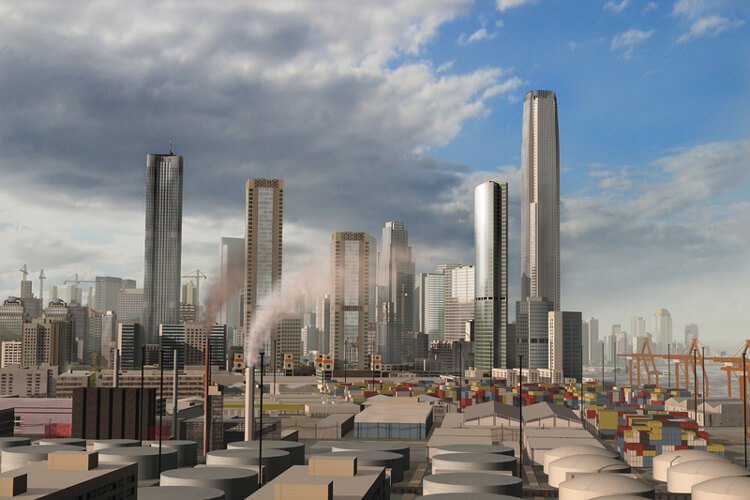
© Chris Jewiss | Dreamstime.com
Vertical farms are appearing in many cities
In an effort to deal with potential food and water shortages, many cities are now building vertical farms.* There are tremendous cost advantages of sourcing food locally, and the farms often use genetic modification processes, allowing them to harvest crops faster.
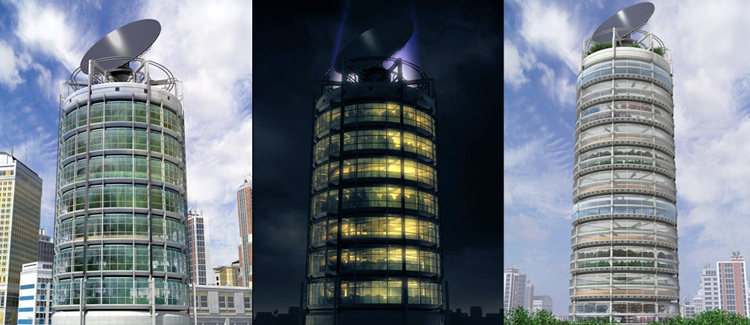
Credit: Chris Jacobs
High-speed rail networks are being expanded in many countries
Many countries have now conducted a radical overhaul of their rail transport infrastructure.
In Spain, more than 10,000km of high-speed track has been laid, making it the most extensive network in the world. 90 percent of the country's population now live within 50km of a bullet train station.*
In the UK, a major high-speed rail line is nearing completion. This will travel up the central spine of the country - connecting London with Birmingham, Manchester, Liverpool, Preston, Glasgow and Edinburgh. Trains will be capable of reaching 200mph, slashing previous journey times by almost half.*
In Japan, Tokyo is now connected with Nagoya and Osaka - along with several smaller cities - via superfast magnetic levitation trains. Tests conducted in previous decades showed that it was possible to build a railway tunnel in a straight route through the Southern Japanese Alps. The first generation of these trains already held the world speed record, at 581 km/h (or 361mph); but recent advances in carriage design have pushed this still further, to over 600 km/hour (or 373mph). This is fast enough to compete with some commercial airliners.*
Many other countries are investing in high-speed rail during this time, due to its sheer speed and convenience, together with soaring fuel costs and environmental factors which have made car and air travel less attractive.
Even the US - which for decades had neglected its rail network - is making huge progress in this area.*

Source: Federal Railroad Administration
Africa and the Middle East are linked by a transcontinental bridge
A 15-year megaproject - costing over $200 billion - has seen the construction of two entire new cities, located at either ends of a 29 kilometre (18 mile) bridge. Dubbed the "Bridge of the Horns", this spans the southern mouth of the Red Sea and connects Yemen (Middle East) to Djibouti (Africa). With support for freight trains, light rail and cars, this greatly facilitates the movement of people, trade and resources between the two continents.*
Each of the hi-tech cities at either end of the bridge is powered almost entirely by renewable energy. They feature many other green technologies and sustainable development practices. As their population swells, they become major commercial, educational and tourist hubs of the region.* A highway is also built, linking them to Dubai.
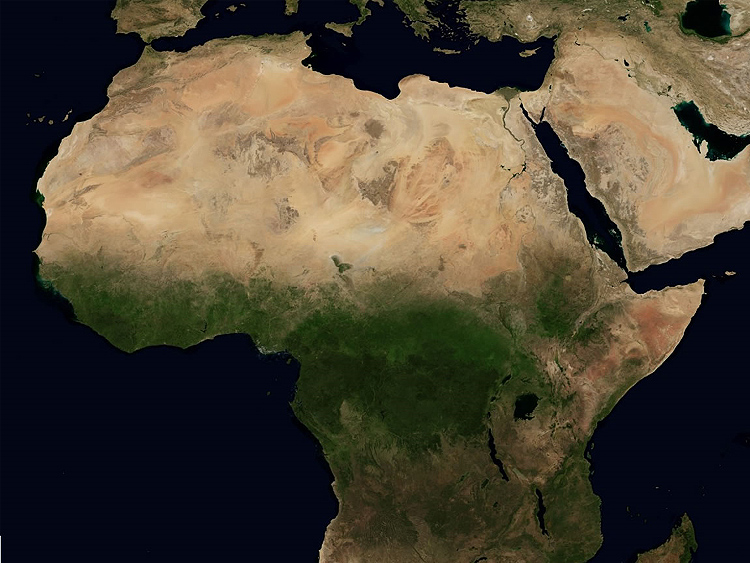
Credit: NASA
Progress with longevity extension
The potential for radical life extension is beginning to enter the public consciousness. Experiments at a university have yielded the first 10 year old mice. Since mice and humans share similar DNA, this "robust rejuvenation" is a major stepping stone towards halting the ageing process in people.*
For those under the age of 50, there is now real and genuine hope of being able to live indefinitely. Though a permanent cure for humans is still many years away, a number of therapies are now in development which can substantially reduce the cell damage, mitochondrial mutations and other adverse effects of ageing. Combined with dietary and lifestyle changes, these temporary measures can be used to buy time for the more dramatic advances in the years ahead - creating a "bridge" to the next era of scientific discovery.
This period marks the beginning of a major increase in public interest and awareness of the subject. At the same time, however, there is a great deal of opposition from religious institutions and conservative groups.
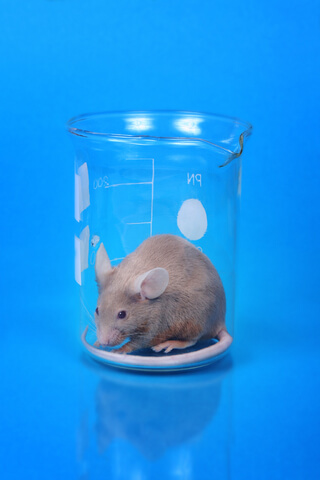
© Emilia Stasiak | Dreamstime.com
Stress and anxiety is reaching crisis levels
By now, a multitude of external factors - intruding into almost every aspect of peoples' day-to-day lives - has led to soaring levels of stress, anxiety and depression. In the early 2000s, around one in four citizens could expect to develop a form of mental illness. By the late 2020s, this has risen to almost one in three.
This is especially true of those living in high density urban centres. Rapid advances in technology and the Internet, rampant consumerism and advertising; the ever increasing work-related stresses, debts, living costs, bad diets, overcrowding and pollution - coupled with loneliness, alienation, and loss of national identity - not to mention the constant scaremongering by media and government; the intensifying problems of climate change, peak oil, and terrorism (plus a host of related security and surveillance measures), along with various health scares originating from overseas... the list goes on and on.
Due to the ongoing energy crisis, frequent blackouts are occurring in many countries during this time, while fuel shortages are commonplace at petrol stations. Meanwhile, record heatwaves and dangerous levels of air pollution are making summers unbearable in some urban areas. In Europe, right-wing nationalist governments are on the rise due to the massive amount of immigration occurring from Africa, the Middle East and elsewhere.
The combined impact of these many factors is having a serious impact on the mental health of citizens.*
Contact with the Voyager probes is lost
Voyager I is now almost 23 billion kilometers from our Sun - or 150 times the distance between the Sun and Earth.
Both probes have remained operational for nearly half a century, continuing to transmit science data back to NASA. They have left the heliosphere entirely and are now headed towards the bow shock - the boundary between the stellar wind and the interstellar medium.
However, by this date, onboard power finally starts to wane. Various instruments begin shutting down, one by one, until eventually all contact is lost.
Each probe carries a gold-plated audio-visual disc, in the event that either spacecraft is ever found by intelligent alien life. The discs carry images of Earth and its lifeforms, a range of scientific information, along with a medley, "Sounds of Earth", that includes the sounds of whales, a baby crying, waves breaking on a shore, a variety of music from different cultures and eras, plus greetings in 60 different languages.*
Rising sea levels are wreaking havoc on the Maldives
At an average of just 1.5m above sea level, the Maldives is the lowest lying country on the planet. Rising sea levels are now beginning to devastate its economy, one-third of which relies on tourism.
The mere talk of a possible submersion, in previous years, had been damaging investor confidence. By this date, however, the tangible reality of global warming is leading to the wholesale abandonment of many islands.*

Credit: Shahee Ilyas
The United States of Africa is established
Following years of diplomatic negotiations, the first truly pan-African government has been formed.* This federation has a combined population of more than a billion. It consists of the 53 sovereign states on the African continent, and extends as far west as the Caribbean to include Haiti, Jamaica and the Dominican Republic.
The union is faced with major challenges - including health issues such as the AIDS epidemic and malaria; political issues such as corruption and civil wars; economic issues such as improving the standard of living of millions of impoverished, uneducated Africans; and environmental issues such as famine and desertification. However, this continental unity marks a turning point for Africa. As trade links improve, wealth and stability increases, and its constituent nations find themselves better able to market their labour, products and resources. Access to education and healthcare is being boosted by a number of technological innovations.
This transformation is a slow, gradual process - but finally there is hope for a peaceful, prosperous Africa. This situation is being mirrored in a number of other Third World countries which are beginning to extend their spheres of influence. With many First World nations facing their own economic and political crises, a more even spread of power is emerging across the globe.
BRICs overtake the G7
By this date, the major emerging markets - Brazil, Russia, India and China, a.k.a. the BRICs - have overtaken the combined GDP of the G7 nations.*
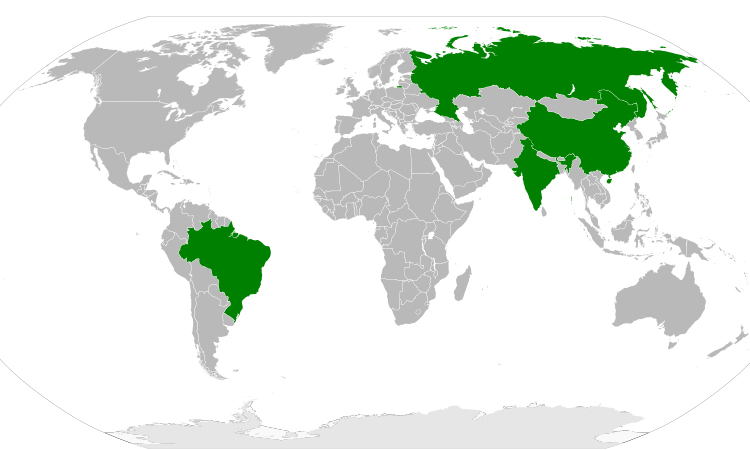
Credit: Felipe Menegaz
Carbon sequestration is underway in many nations
Following years of research and development, a number of geoengineering techniques are now being utilised for trapping and removing CO2. This is offering fresh hope for mitigating the effects of climate change.
The most significant technology is "clean coal", being fitted to power plants. This is seeing widespread adoption, since it now costs less than unsequestered coal-based power generation.* The carbon dioxide is stored in geological formations deep underground (including some empty oil wells). Great care and precision must be taken in choosing these sites, however, as dumping the gas in an unstable location may cause it to leak back up to the surface or contaminate aquifers used for drinking supplies.
Another method of carbon sequestration which is showing great potential is the deployment of "artificial trees". These are shaped like giant fly swatters around 10m high, and are becoming an increasingly common sight along roads, freeways and other polluted areas.* The trees capture CO2 through a filter - thousands of times more efficiently than real trees - which is then removed and stored.
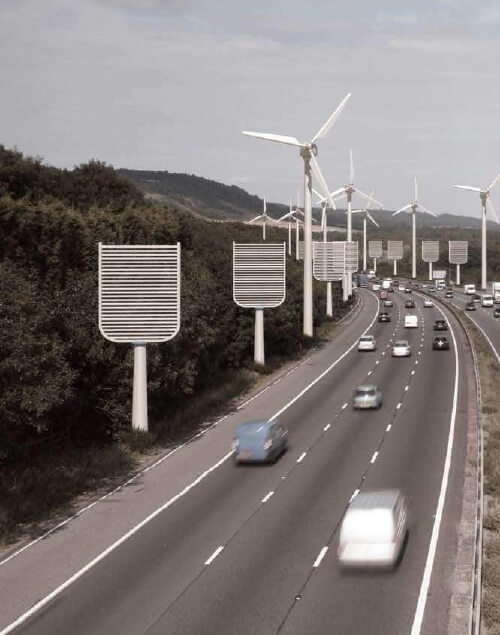
Credit: Institution of Mechanical Engineers
Another geoengineering project involves strips of algae, fitted to the sides of buildings, which naturally absorb CO2 through photosynthesis. They are most common in high-density urban centres, where tall buildings offer a much greater surface area. These "photobioreactors" (as they are called) not only sequest carbon, but can also produce biofuel and biochar as beneficial side effects. The biofuel can be used to generate energy whilst keeping net carbon emissions to zero, while the biochar can be used as a very good fertiliser.*
Yet another project is the addition of highly reflective panels on rooftops. These reflect sunlight back into space, reducing the amount of solar radiation being absorbed by the Earth.
Although efficient, the geoengineering techniques described above (along with various others) do not represent the ultimate solution to global warming. They are only a temporary measure. The only effective, long-term process for stabilising the earth's climate remains the large-scale adoption of solar, wind, hydro, nuclear and other renewable energy sources.
Printed electronics are ubiquitous
The printed electronics market has seen exponential growth. By now, it has ballooned to over $300 billion globally - even overtaking the silicon integrated circuit industry.*
This technology began with a small number of niche, high-end products. It expanded rapidly in the 2010s, thanks to plummeting costs and improved production methods. By the 2020s it had exploded into the mainstream – creating a whole new generation of ultra-thin electronics.
Today, these have such low fabrication costs that they are ubiquitous, being present in countless everyday business and consumer applications. Many previously bulky and heavy devices can now be folded, stored or carried as easily as sheets of paper. This includes flexible TV displays that can be rolled or hung like posters, wearable mobile phones, electronic newspapers with moving pictures, disposable netbooks, "smart" packaging and labels with animated text, signage in retail outlets that can be updated shop-wide at the touch of a button.*
Multimedia players with expandable, fold-out touchscreens are especially popular. Even low-end models are now the size and weight of credit cards and can easily fit inside a wallet. With petabytes of storage, gigapixels of screen resolution and superfast transfer speeds, they are millions of times more powerful than iPods of previous decades. They are also completely wireless - no cables or physical connections of any kind are required, and music can be enjoyed using wireless earphones.

UK population reaches 70 million
Britain will soon become the most populous country in Europe, overtaking both Germany and France. This is mainly due to vast numbers of immigrants. Combined with a shrinking labour force, this is putting an enormous strain on public services - especially in London, which has born the brunt of this increase.
The East End has been transformed in recent years, becoming almost a whole new city within London, and beginning to rival the West End. Vast areas of land have been redeveloped with hundreds of new residential developments, office towers, retail masterplans, green spaces and public areas - all built to the highest environmental standards.
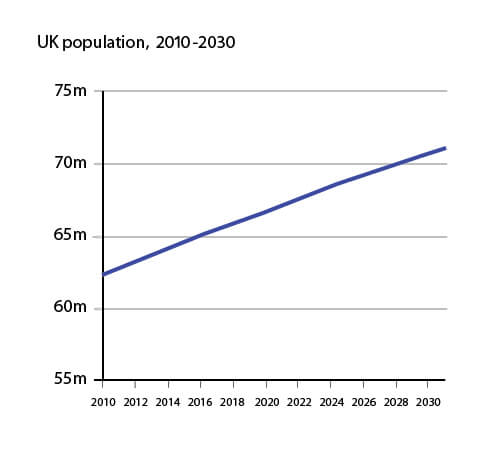
Source: Office for National Statistics
Manned fighter planes are being phased out and replaced with UAVs
By this date, the A-10 Thunderbolt II has been replaced completely by the F-35 Lightning II - which itself becomes one of the last remaining manned fighter planes in the US military. The F-35 will remain in operation until the 2040s, eventually being replaced by a new generation of unmanned aerial vehicles (UAVs) controlled by advanced AI.

Amputees can regrow lost limbs
Drugs are now available that can stimulate human cells to regrow entire limbs.* By switching off a particular gene known as P21, adult mammalian cells can be induced to behave like regenerative embryonic stem cells.*
The treatments are applied transiently during the healing process and only locally at the wound site, which also minimises any side effects.
Further into the future, spinal cords and even damaged brains will be capable of being regenerated.*

Credit: Spauln
Human-like AI is becoming a reality
A major milestone is reached in the field of AI research this year, as a computer passes the Turing Test for the very first time.** In a virtual reality setting, a human judge is made to engage in a natural language conversation with one human and one machine, each of which tries to appear human. The participants are placed in isolated locations.
Graphics and voice effects have already progressed to the point that CGI characters are visually indistinguishable from real people. However, computer intelligence and interaction has also grown exponentially, such that the judge is now literally unable to tell the machine from the real human.*
Answers to certain "obscure" questions posed by the judge may appear slightly childlike from the AI - but they are humanlike nonetheless.*

© Rolffimages | Dreamstime.com
Automation of supermarkets and retail environments
In developed nations, the majority of retail environments are now cashless. Automated systems have made it possible for customers to shop with little or no physical interaction with a checkout.
Items are simply "scanned" as they pass through the door. The customer is identified either by a chip in their card, or with a prepayment transponder obtained from a vending machine outside the store. Transactions are then generated instantly and wirelessly over the Internet.
This system greatly saves time, improves security and reduces costs for the retailer by eliminating the need for checkout staff.
Intelligent advertising
Personalised adverts, similar in style to those seen in the film Minority Report, are becoming widespread by the end of this decade.* Microsensors embedded in posters and other outdoor media can identify people by the chips in their mobile phone, credit card and other personal effects. These adverts are then customised depending on the personal habits, interests and lifestyle of the person in question.
Pairs of ultrasonic beams - targeted to intersect at specific points - deliver a localised sound message that only a single person can hear. This means that even in crowded situations, the adverts can be made personal and unique.
Civil liberties campaigners decry the use of such technology, given the rise in anxiety, paranoia and other mental illness resulting from such marketing tactics; but the demands of business win through.
Titan Saturn System Mission (TSSM)
This is a joint NASA/ESA mission involving the exploration of Saturn and its moons. The craft is launched in 2020, and goes through a total of four gravity assists (Earth-Venus-Earth-Earth), before finally reaching Saturn in 2029.*
Detailed, close-range imaging is conducted of both Titan and Enceladus - including a flyby into Titan's lower atmosphere with a hot air balloon, just a few miles above the surface. This takes place over the equator and lasts for six months, returning a vast amount of data. Equipped with ultra-high resolution cameras, the probe reveals in stunning detail the landscapes of this strange alien world.
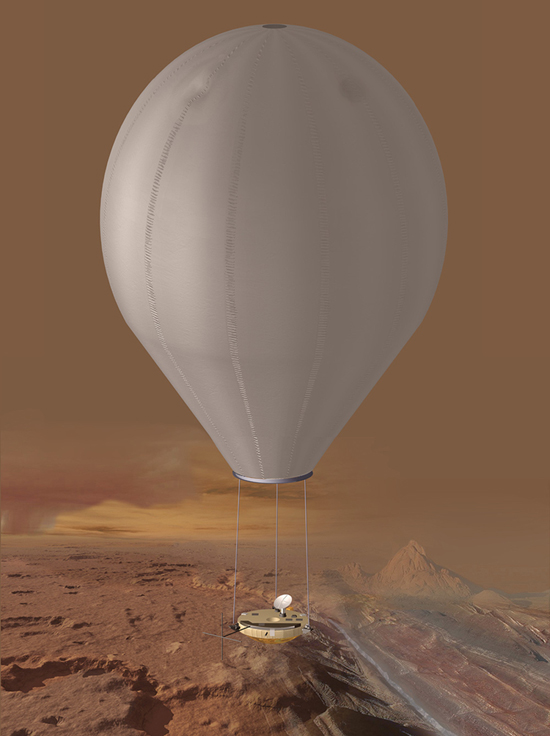
On its second Titan flyby, a surface lander is released by the orbiter. This is targeted over Kraken Mare, a northern polar sea of icy hydrocarbons. The probe descends by parachute, like the Huygens probe of 2005. A few hours later, it hits the liquid surface - becoming the first ever floating exploration of an extraterrestrial sea.
The battery-operated craft's principal function is to sample and analyze organics on the surface for a period of nine hours, including six hours of atmospheric descent and three or more hours on the surface. Both probes' data are relayed to the Titan orbiter.
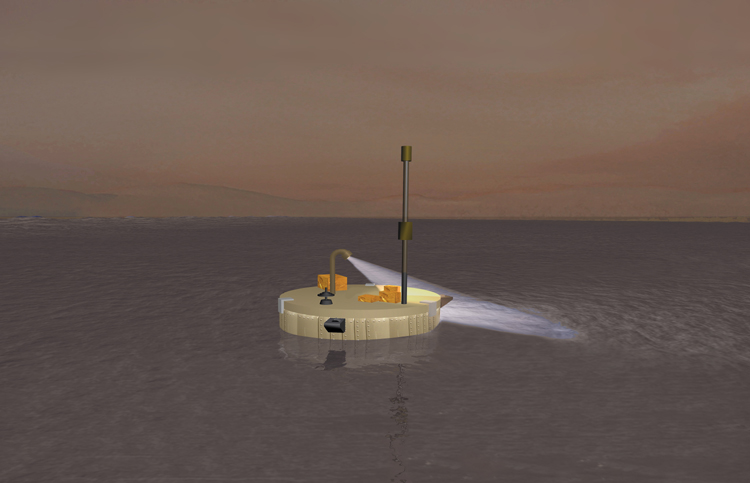
Lake Chad disappears from the map
In the 19th century, Lake Chad was among the largest lakes in the world. It supported a vast ecosystem of fish, waterfowl, crocodiles, shore birds and other animals.
Due to the combined effects of drought, irrigation and human activity, it has disappeared entirely by now.* This is having a devastating impact on Niger, Nigeria, Chad and Cameroon - with over 30 million people depending on the lake for agriculture, drinking water, livestock, fishing and other purposes.
Vast numbers of refugees are now moving to elsewhere on the continent.
References
1 When will the oil run out?, Guardian.co.uk:
http://www.guardian.co.uk/business/2008/dec/15/oil-peak-energy-iea
Accessed 24th July 2009.
2 http://www.lifeaftertheoilcrash.net/
Accessed 24th July 2009.
3 10 fool-proof predictions for the Internet in 2020, Network World:
http://www.networkworld.com/news/2010/010410-outlook-vision-predictions.html?page=1
Accessed 7th January 2010.
4 Japan eyes 'mind-reading' devices, robots 'by 2020', AFP:
http://www.google.com/hostednews/afp/article/ALeqM5hqCisAKzlmkDyAyubLEg4zR_wshg
Accessed 24th April 2010.
5 The Brain Twitter Interface, YouTube:
http://www.youtube.com/watch?v=205dHV55XWQ
Accessed 24th April 2010.
6 British team grows human heart valve from stem cells, Guardian.co.uk:
http://www.guardian.co.uk/science/2007/apr/02/stemcells.genetics
Accessed 7th May 2009.
7 21st Century Medicine - Organ preservation for transplantation, 21st Century Medicine:
http://www.21cm.com/transplant.html
Accessed 24th February 2010.
8 Holographic TV could be here by 2020, dvice.com:
http://dvice.com/archives/2008/10/holographic_tv.php
Accessed 22nd November 2009.
9 Sweden raises the renewable energy bar, Tree Hugger:
http://www.treehugger.com/files/2006/01/sweden_raises_t.php
Accessed 1st Jan 2009.
10 No More Glaciers in Glacier National Park by 2020?, National Geographic:
http://news.nationalgeographic.com/news/2009/03/090302-glaciers-melting.html
Accessed 12th April 2009.
11 Climate Change, Water, and the Himalayas, Woodrow Wilson International Center for Scholars:
http://www.wilsoncenter.org/index.cfm?topic_id=1421&fuseaction=topics.event_summary&event_id=479527
Accessed 12th April 2009.
12 SKA - Square Kilometre Array, skatelescope.org:
http://www.skatelescope.org
Accessed 8th June 2009.
13 Lifelike animation heralds new era for computer games, The Times Online:
http://technology.timesonline.co.uk/tol/news/tech_and_web/article4557935.ece.
Accessed 12th Sept 2008.
14 The airport security scanner that can read your mind, Daily Mail:
http://www.dailymail.co.uk/sciencetech/article-1060972/The-airport-security-scanner-read-mind.html
Accessed 22nd April 2010.
15 Interview of Richard Varvill of Reaction Engines and the Skylon Spaceplane by Sander Olson, Next Big Future:
http://nextbigfuture.com/2009/10/interview-of-richard-varvill-of.html
Accessed 17th November 2009.
16 SKYLON - Passenger Capabilities, Reaction Engines Limited:
http://www.reactionengines.co.uk/skylon_pax.html
Accessed 17th November 2009.
17 Complex Integrated Circuits Made of Carbon Nanotubes, Technology Review:
http://www.technologyreview.com/computing/24236/page1/
Accessed 4th January 2010.
18 Lake Mead Water Level Dropping, enviro-news.com:
http://www.enviro-news.com/article/lake_mead_water_level_dropping.html
Accessed 9th June 2009.
19 Lake Mead water level will be trigger for pipeline, MercuryNews.com:
http://www.mercurynews.com/breakingnews/ci_12534526?nclick_check=1
Accessed 9th June 2009.
20 Nanotech clothing fabric 'never gets wet', New Scientist:
http://www.newscientist.com/article/dn16126-nanotech-clothing-fabric-never-gets-wet.html
Accessed 10th April 2009.
21 Bioengineered Tooth Regeneration in Mice, Next Big Future:
http://nextbigfuture.com/2009/08/bioengineered-tooth-regeneration-in.html
Accessed 16th April 2010.
22 Nanopiezoelectronics, Technology Review:
http://www.technologyreview.com/read_article.aspx?ch=specialsections&sc=tr10&id=22118
Accessed 19th April 2009.
23 Aiming to Cure Deafness, Scientists First to Create Functional Inner-Ear Cells, Science Daily:
http://www.sciencedaily.com/releases/2010/05/100513123720.htm
Accessed 15th May 2010.
24 "Construction of the HiPER facility is envisaged to start mid-decade, with operation in the early 2020s."
See HiPER Project - Key Facts, hiper-laser.org:
http://www.hiper-laser.org/keyfacts/KeyFacts.asp
Accessed 28th March 2010.
25 Home, YouTube.com:
http://www.youtube.com/watch?v=jqxENMKaeCU
Accessed 14th June 2009.
26 Wild Orangutans: Extinct by 2023?, nationalgeographic.com:
http://news.nationalgeographic.com/news/2003/09/0930_030930_orangutanthreat.html
Accessed 14th June 2009.
27 Gorillas Could be Extinct in the Congo Basin by the Mid-2020s, Tree Hugger:
http://www.treehugger.com/files/2010/03/gorillas-could-be-extinct-in-the-congo-basin-by-the-mid-2020s.php
Accessed 14th April 2010.
28 Turkey seeks self-sufficiency in oil production by 2023, Sunday's Zaman:
http://www.sundayszaman.com/sunday/detaylar.do?load=detay&link=172220
Accessed 4th May 2009.
29 Such a disaster could emerge "in the next ten to 15 years", according to Peter Schwartz, chairman of Global Business Network.
See Wired (UK launch issue - May 2009):
http://www.wired.co.uk
Accessed 8th April 2009.
30 Flooded future looms for Bangladesh, BBC News:
http://news.bbc.co.uk/1/hi/sci/tech/4056755.stm
Accessed 8th April 2009.
31 African elephants could be extinct in 15 years, The Telegraph:
http://www.telegraph.co.uk/earth/wildlife/6364726/African-elephants-could-be-extinct-in-15-years.html
Accessed 19th October 2009.
32 The Singularity is Near, by Ray Kurzweil (2005)
http://www.amazon.com/Singularity-Near-Humans-Transcend-Biology/dp/0143037889/ref=sr_1_1?ie=UTF8&s=books&qid=1254172463&sr=1-1
Accessed 7th Dec 2008.
33 China to build 10 New Yorks by 2025, International Construction Review:
http://www.ciobinternational.org/news/view/1393.
Accessed 9th Sept 2008.
34 Timeline of the Chinese Nuclear Industry, 1970 to 2020, Energy Information Administration:
http://www.eia.doe.gov/cneaf/nuclear/page/nuc_reactors/china/timeline.html.
Accessed 9th Sept 2008.
35 An urban site of just 1.32 hectars would be capable of producing the same amount of food as 420 hectars (1052 acres) of traditional farming, and could feed tens of thousands of citizens. This increased efficiency would be achieved by stacking floors like a skyscraper, and utilising a tightly controlled growing environment with hydroponics and other technologies.
36 Trains in Spain signal the future, BBC.co.uk:
http://news.bbc.co.uk/1/hi/world/europe/8268003.stm
Accessed 26th Sept 2009.
37 New high-speed rail plan unveiled, BBC.co.uk:
http://news.bbc.co.uk/1/hi/business/8221540.stm
Accessed 26th Sept 2009.
38 Japanese Maglev, 500km/h, YouTube:
http://www.youtube.com/watch?v=NQyj-3C99bA
Accessed 26th Sept 2009.
39 High-Speed Rail, Federal Railroad Administration:
http://www.fra.dot.gov/us/content/31
Accessed 26th Sept 2009.
40 Bridge of the Horns, Noor City Development Corporation:
http://www.ncdcme.com/BridgeOfHorns.htm
Accessed 17th April 2010.
41 Aubrey de Grey's Prediction for 2020, YouTube:
http://www.youtube.com/watch?v=C4uJ7rq1qX8
Accessed 8th April 2009.
42 UK society 'increasingly fearful', BBC.co.uk:
http://news.bbc.co.uk/1/hi/health/7988310.stm
Accessed 1st May 2009.
43 Voyager Golden Record, goldenrecord.org:
http://goldenrecord.org
Accessed 4th October 2009.
44 Maldives rises to climate challenge, BBC:
http://news.bbc.co.uk/1/hi/7946072.stm
Accessed 18th December 2009.
45 United States of Africa, Wikipedia:
http://en.wikipedia.org/wiki/United_States_of_Africa
Accessed 14th June 2009.
46 What's called a 'global' recession is in fact shrinking economies mainly in the West, not the East, Newsweek:
http://www.newsweek.com/id/190387
Accessed 16th November 2009.
47 Coal Utilization Research Council - EPRI Roadmap, Coal.org:
http://www.coal.org/roadmap/index.asp
Accessed 28th August 2009.
48 'Artificial trees' to cut carbon, BBC:
http://news.bbc.co.uk/1/hi/sci/tech/8223528.stm
Accessed 28th August 2009.
49 Geo-engineering, Institution of Mechanical Engineers:
http://www.imeche.org/about/keythemes/environment/Climate+Change/Geoeng
Accessed 28th August 2009.
50 Can the 'silver bullet' of printing revolutionize electronics?, CNN:
http://edition.cnn.com/2009/TECH/12/09/electronics.printer.xerox/index.html
Accessed 16th December 2009.
51 Microsoft's future vision on retailing, YouTube:
http://www.youtube.com/watch?v=2nvqVU1fBPI
Accessed 16th December 2009.
52 "We may be only a decade or two away from a day when we can regenerate human body parts."
See Scientists Develop Powder to Regrow Limbs, Finding Dulcinea:
http://www.findingdulcinea.com/news/science/May-June-08/Scientists-Develop-Powder-to-Regrow-Limbs.html
Accessed 17th March 2010.
53 Humans could regrow body parts like some amphibians, The Daily Telegraph:
http://www.telegraph.co.uk/health/healthnews/7448557/Humans-could-regrow-body-parts-like-some-amphibians.html
Accessed 17th March 2010.
54 "... I make the case in The Singularity Is Near that we'll have both the hardware and the software to create human-level intelligence by 2029. I've been consistent on that date."
See An Interview With Ray Kurzweil, Techland:
http://techland.com/2010/04/02/an-interview-with-ray-kurzweil/
Accessed 23rd May 2010.
55 The Singularity is Near, by Ray Kurzweil (2005)
http://www.amazon.com/Singularity-Near-Humans-Transcend-Biology/dp/0143037889/ref=sr_1_1?ie=UTF8&s=books&qid=1254172463&sr=1-1
Accessed 23rd May 2010.
56 "... We will have entities by 2030 that seem to be conscious, and that will claim to have feelings. We have entities today, like characters in your kids' video games, that can make that claim, but they are not very convincing. If you run into a character in a video game and it talks about its feelings, you know it's just a machine simulation; you're not convinced that it's a real person there. This is because that entity, which is a software entity, is still a million times simpler than the human brain.
In 2030, that won't be the case. Say you encounter another person in virtual reality that looks just like a human but there's actually no biological human behind it - it's completely an AI projecting a human-like figure in virtual reality, or even a human-like image in real reality using an android robotic technology. These entities will seem human. They won't be a million times simpler than humans. They'll be as complex as humans. They'll have all the subtle cues of being humans. They'll be able to sit here and be interviewed and be just as convincing as a human, just as complex, just as interesting. And when they claim to have been angry or happy it'll be just as convincing as when another human makes those claims.
At this point, it becomes a really deeply philosophical issue. Is that just a very clever simulation that's good enough to trick you, or is it really conscious in the way that we assume other people are?"
See After the Singularity: A Talk with Ray Kurzweil , KurzweilAI.net:
http://www.kurzweilai.net/articles/art0451.html?printable=1
Accessed 23rd May 2010.
57 Kurzweil's prediction is controversial, with many believing it to be rather optimistic. However, I have included it here anyway. He has an impressive track record of predictions - correctly forecasting the collapse of the Soviet Union, the rise of the Internet, the completion of the Human Genome Project, and the date when a computer would beat a human chess player.
58 Wired (UK launch issue - May 2009):
http://www.wired.co.uk
Accessed 18th April 2009.
59 Outer Planet Flagship Mission: TSSM Study Overview, Nasa.gov:
http://opfm.jpl.nasa.gov/titanriskreduction/tssmoverview/
Accessed 11th May 2009.
60 Study: Niger to suffer from the shrinking Lake Chad, PRLog:
http://www.prlog.org/10383828-study-niger-to-suffer-from-the-shrinking-lake-chad.html
Accessed 23rd November 2009.




No comments:
Post a Comment